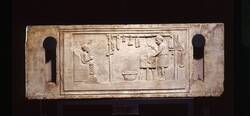In the centre of the relief, a pork butcher's wares are depicted hanging neatly on a rack: Pig's head, offal, sow's udder, pig's bones, a leg and a piece of rib. On the right edge of the picture, a cleaver, a weighing pan and a quick balance speak for correct and professional work in the butcher's shop. The master himself stands at his chopping block and cuts up a piece of ribs. Leftover meat is disposed of in the bowl in front of him. Opposite him, his wife is enthroned on a high armchair, taking stock of business in a book with wax tablets. While the man is wearing comfortable work clothes, consisting of a short-sleeved tunic and boots, the woman is wearing elegant robes and an elegant turban of plaited plaits, as was fashionable at the time. The relief was probably originally attached to the façade of a small tomb that stood along one of Rome's arterial roads. This is indicated by the two slits on the side, which served to ventilate the burial chamber. Roman tomb reliefs depicting professions were popular memorials from the 2nd century AD onwards and tell of honest work, social success and social participation.
Further Media
It is not only Asterix and Obelix who serve up an entire wild boar for dinner – that also became fashionable in Rome during Caesar’s lifetime. No doubt this culinary trend made the renowned statesman and scholar Cato the Elder turn in his grave, since he reputedly once gave a speech against eating pork crackling. Just a few generations later, the change in habits led the historian Pliny to note:
‘That’s how recent the origins are of what is now an everyday affair.’
But in reality, ‘everyday’ here only referred to a select circle of the wealthy. Nonetheless, pork was certainly popular and, as demand increased, pigs were more intensively reared. Pliny evidently knew enough about pig keeping to write later:
‘Beech mast fed to pigs livens them up, making their flesh easy to cook and light and digestible, whereas the acorns of the holm-oak make a pig thin, delicate and glossy. Acorns from the common oak which are the largest and sweetest of all, make a pig heavy, fat and corpulent. … No other animal provides gourmets with a far richer fare – namely nearly fifty different dainties, while other animals only provide one each.’
But, he also added a warning:
‘People benefit most from simple dishes. An accumulation of delicacies is unhealthy’
- Location & Dating
- c. 140/150 CE
- Material & Technique
- Marble
- Dimenions
- H: 38,0 cm, B: 103,5 cm, T: 5,0 cm Gewicht: 37 kg Innenmaße: 34,5 x 67,3 cm
- Museum
- Skulpturensammlung
- Inventory number
- Hm 418

